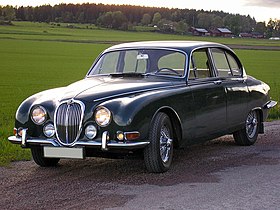
Jaguar is the sports car and luxury vehicle brand of Jaguar Land Rover, a British multinational car manufacturer with its headquarters in Whitley, Coventry, England. Jaguar Cars was the company that was responsible for the production of Jaguar cars until its operations were fully merged with those of Land Rover to form Jaguar Land Rover on 1 January 2013.

The Jaguar X-Type is a car built by British marque Jaguar from 2001 to 2009. Considered a large family car in Europe and a compact car in the US, the X-Type has either a four-door saloon or a five-door estate body style and was sold in the compact-executive market segment. Given the internal designation X400, its engine is in the front and there are front-wheel drive and all-wheel drive variants. In addition to offering Jaguar's first estate car in series production, the X-Type would ultimately introduce its first diesel engine, four-cylinder engine and front-wheel drive configuration.

The Jaguar XK is a two-door 2+2 grand tourer manufactured and marketed by Jaguar Cars from 1996–2012 and by Jaguar Land Rover from 2013–2014 in hatchback coupé and convertible body styles, across two generations. The XK was introduced at the Geneva Motor Show in March 1996 and was discontinued in July 2014.

The Jaguar E-Type, or the Jaguar XK-E for the North American market, is a British front mid-engined sports car that was manufactured by Jaguar Cars Ltd from 1961 to 1974. Its combination of exceptional aesthetics, advanced technologies, high performance, and competitive pricing established the model as an icon of the motoring world. The E-Type's claimed 150 miles per hour (240 km/h) top speed, sub-7-second 0 to 60 mph (97 km/h) acceleration, largely unitary body construction, front and rear independent suspension with disc brakes, mounted inboard at the rear, and rack-and-pinion steering, distinguished the car and spurred industry-wide changes.

The Jaguar XK150 is a sports car produced by Jaguar between 1957 and 1961 as the successor to the XK140.

The Jaguar XJ is a series of mid-size/full-size luxury cars produced by British automobile manufacturer Jaguar Cars from 1968 to 2019. It was produced across five basic platform generations with various updated derivatives of each. From 1970, it was Jaguar's flagship four-door model. The original model was the last Jaguar saloon to have been designed under the leadership of Sir William Lyons, the company's founder, and the model has been featured in countless media and high-profile appearances.

The Jaguar XK is an inline 6-cylinder dual overhead camshaft (DOHC) engine produced by Jaguar Cars between 1949 and 1992. Introduced as a 3.4-litre, it earned fame on both the road and track, being produced in five displacements between 2.4 and 4.2-litres for Jaguar passenger cars, with other sizes being made by Jaguar and privateers for racing. A de-rated version was also used in certain military vehicles built by Alvis and Daimler.

The Jaguar Mark X, later renamed the Jaguar 420G, was British manufacturer Jaguar's top-of-the-range saloon car for a decade, from 1961 to 1970. The large, luxurious Mark X not only succeeded the Mark IX as the company's top saloon model, but radically broke with both its predecessor's styling and technology.

The Jaguar Mark 2 is a mid-sized luxury sports saloon built from late 1959 to 1967 by Jaguar in Coventry, England. The previous Jaguar 2.4 Litre and 3.4 Litre models made between 1955 and 1959 are identified as Mark 1 Jaguars.
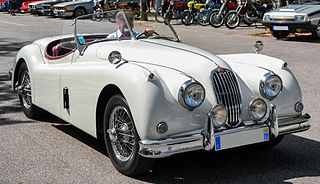
The Jaguar XK140 is a sports car manufactured by Jaguar between 1954 and 1957 as the successor to the XK120. Upgrades included more interior space, improved brakes, rack and pinion steering, increased suspension travel, and telescopic shock absorbers instead of the older lever arm design.
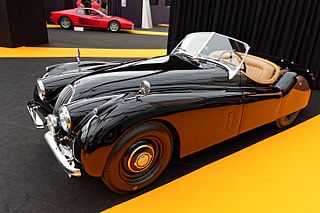
The Jaguar XK120 is a sports car manufactured by Jaguar between 1948 and 1954. It was Jaguar's first sports car since SS 100 production ended in 1939.
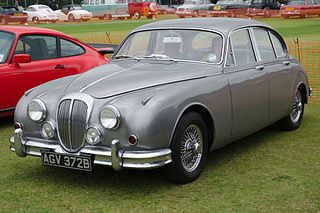
The Daimler 2.5 V8/V8-250 is a four-door saloon which was produced by The Daimler Company Limited in the United Kingdom from 1962 to 1969. It was the first Daimler car to be based on a Jaguar platform, the first with a unit body, and the last to feature a Daimler engine after the company was bought from the Birmingham Small Arms Company by Jaguar Cars in 1960. The engine is the hemispherical head V8 designed by Edward Turner and first used in the Daimler SP250 sports car.
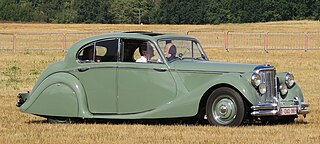
The Jaguar Mark V is a luxury automobile built by Jaguar Cars Ltd of Coventry in England from 1948 to 1951. It was available as a four-door Saloon (sedan) and a two-door convertible known as the Drop Head Coupé, both versions seating five adults. It was the first Jaguar with independent front suspension, first with hydraulic brakes, first with spats, first specifically designed to be produced in both Right and Left Hand Drive configurations, first with disc centre wheels, first with smaller wider 16" balloon tyres, first to be offered with sealed headlamps and flashing turn signals for the important American market, and the last model to use the pushrod engines.
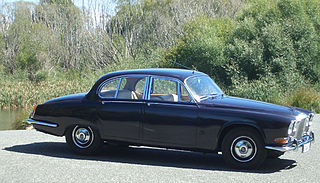
Daimler Sovereign was a name applied by British manufacturer Jaguar Cars to a sequence of luxury automobiles built by it but carrying the Daimler badge between 1966 and 1983.

William 'Bill' Munger Heynes CBE, born in Leamington Spa, was an English automotive engineer.
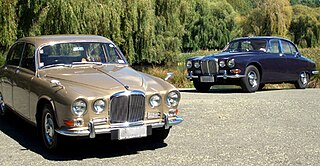
The Jaguar 420 and its Daimler Sovereign equivalent were introduced at the October 1966 London Motor Show and produced for two years as the ultimate expression of a series of "compact sporting saloons" offered by Jaguar throughout that decade, all of which shared the same wheelbase. Developed from the Jaguar S-Type, the 420 cost around £200 more than that model and effectively ended buyer interest in it, although the S-Type continued to be sold alongside the 420/Sovereign until both were supplanted by the Jaguar XJ6 late in 1968.

The Jaguar XJ (X350) is a full-size four-door luxury saloon car manufactured and marketed worldwide by Jaguar Cars for model years 2003–2009 as the third generation of the Jaguar XJ saloon, carrying the internal designation X350 and the internal designation X358 following its 2007 intermediate facelift. Both the X350 and X358 were available with a six-speed automatic transmission, a range of petrol and diesel engines, numerous trim levels, and short wheelbase (2003–2009) or long wheelbase (2005–2009) car body configurations. Extended-length models were the longest vehicles Jaguar had manufactured.

The Jaguar XK is the second and final generation of the Jaguar XK 2+2 grand tourer manufactured and marketed by British automobile manufacturer Jaguar Cars under the X150 internal designation. The three-door fastback coupé debuted at the 2005 Frankfurt Motor Show with the 4.2-litre V8 engine of its predecessor, and the two-door convertible debuted in 2006 at the North American International Auto Show.

The Jaguar XK8 is a grand tourer launched by Jaguar Cars in 1996, and was the first generation of a new XK series. The XK8 was available in two-door coupé or two-door convertible body styles with the new 4.0-litre Jaguar AJ-V8 engine. In 1998, the XKR was introduced with a supercharged version of the engine. In 2003, the engines were replaced by the new 4.2-litre AJ34 engines in both the naturally aspirated and supercharged variations. The first-generation of the XK series shares its XJS-derived platform with the Aston Martin DB7, with both cars tracing their history back to an abandoned Jaguar development study in the mid-1980s known as XJ41/XJ42, which had been mooted to be known as the F-Type.
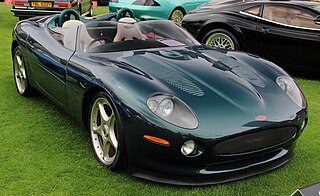
The Jaguar XK 180 is a concept car created by the British car manufacturer Jaguar Cars to celebrate the 50th anniversary of the XK car and to show the world the skills of Jaguar stylists, craftsmen and engineers. It was presented at the Paris Motor Show in 1998.
